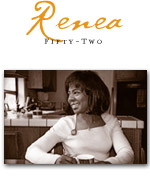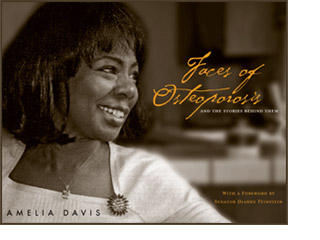Books :: Faces of Osteoporosis
Renowned photographer Amelia Davis turns her lens on those living with osteoporotic disease in her fascinating new book, Faces of Osteoporosis. With this beautifully illustrated work, Ms. Davis communicates the message that osteoporosis affects both women and men across the life span, is both preventable and treatable, and should not be considered part of normal aging. In the United States alone there are almost 35 million people living with the disease and that number continues to grow.
The book’s beautiful photographs and candid personal stories will have a positive affect on the way people view individuals with osteoporosis, and serve as a touchstone for those living with this condition. It smashes the stereotype of osteoporosis as a disease of older women, showing that the disease has myriad faces, not just one.

excerpt from the book
Osteoporosis is a disease of the bone that I, along with many others, associated with the elderly. Especially those who had visual signs of the disease—a hump in their back, walking severely bent over with a cane, or unable to stand up straight.
My attitude and perception changed when I learned that I had osteoporosis! I was hit by a car in February 2003, resulting in the need to stay off of my feet for several months while the broken bones healed. It was after this accident that I participated in a class that taught technicians how to use the bone-density testing machines and prepare and read test results. As a result of participating in this activity, I learned that I had a severe case of osteoporosis. It was then that I knew I had to do something to strengthen my bones to avoid the other debilitating characteristics that come with the disease. At the same time, I began a search for the reasons I developed osteoporosis. After all, I didn’t have a small frame and I wasn’t in one of the higher-risk ethnic groups.
In January 2003, I was asked to volunteer as a member of the Finance Committee for the Foundation for Osteoporosis Research and Education (FORE). As a committee member, I learned of the campaign to inform men and women in their thirties of the disease and its impact. The underlying message throughout the campaign was that osteoporosis is not something that we should expect or accept as part of the normal aging process. Instead, with proper diet, exercise, and the right information, osteoporosis is a disease whose affects can be minimized or completely deterred.
I have never been one to take calcium supplements, nor drink milk, other than with cereal. I exercised daily and ate healthy foods. However, I was post-menopausal and had been taking medication to control epilepsy for thirty years. I enjoyed an ample daily dose of caffeinated beverages. In combination, prolonged use of anti-seizure medication, minimal intake of calcium and vitamin D, and my daily intake of caffeine contributed to the decrease in bone mass.
Today, I purposely find ways to ingest calcium in the form of calcium with vitamin D supplements, yogurt, and cheese. In addition, I look for calcium in its natural fruit and vegetable sources—like calcium-enriched orange juice, almonds, sunflower seeds, and leafy green vegetables. Although I cannot participate in aerobics, I can walk and use exercise equipment that helps to build muscle and bone mass.
I no longer think of osteoporosis as an older persons’ disease. I take every opportunity to share with the twenty- and thirty-somethings that they are at risk if they don’t eat right and keep themselves in shape. I’ve always been a catalyst for change. It’s great to know that, unlike many of the other diseases we hear about today, there is something that we can do to alter the results. Keep moving!









 Purchase Faces of Osteoporosis from amazon.com
Purchase Faces of Osteoporosis from amazon.com